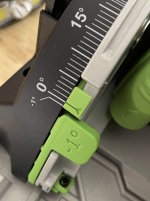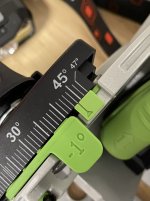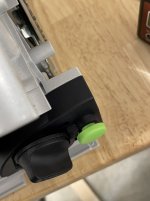Almighty FOG,
I'm a new owner of TSC 55 KEB and so far its been quite frustrating cutting 45 degree w/ the saw.
The saw came out of square at 90 so I did some adjustment using the small black screw in pic 1, also I set the scale to point to 0 (Thanks forum this post).
I need to do a series of 45 degree cuts -- now the natural stop position when tilted (adjusted for 0) is off by a tick (pic 2), and is no where near 45..
For my 45 degree cut I had to lose the nob (pic 3) and do manual adjustment (at this point neither 45 mark nor the stop is correct), I had to measure on the blade angle, which need to be slightly beyond the stop but hard to repeat each time due to the thick scale mark.
Is there an easy fix on my situation? Is that something I should contact festool directly and get helps/replacement? Any pointer is welcome and GREATLY APPRECIATED. I want to love and use this saw.
Thanks in advance for education. I'm all ears.
Thank you
I'm a new owner of TSC 55 KEB and so far its been quite frustrating cutting 45 degree w/ the saw.
The saw came out of square at 90 so I did some adjustment using the small black screw in pic 1, also I set the scale to point to 0 (Thanks forum this post).
I need to do a series of 45 degree cuts -- now the natural stop position when tilted (adjusted for 0) is off by a tick (pic 2), and is no where near 45..
For my 45 degree cut I had to lose the nob (pic 3) and do manual adjustment (at this point neither 45 mark nor the stop is correct), I had to measure on the blade angle, which need to be slightly beyond the stop but hard to repeat each time due to the thick scale mark.
Is there an easy fix on my situation? Is that something I should contact festool directly and get helps/replacement? Any pointer is welcome and GREATLY APPRECIATED. I want to love and use this saw.
Thanks in advance for education. I'm all ears.
Thank you



